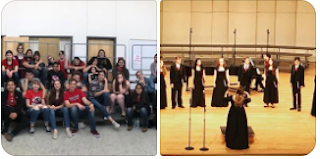It's March, and it's contest season!
This is my 26th school year teaching middle school beginners. I've taught in 3 states in the USA, and it is quite interesting to experience the differences in expectations at the various state sight singing adjudications. Standards change over time, but here is my experience with sight singing in the three states in which I have taught:
1) In North Carolina in the early 1990's, where I began my career, my students had to read unison
a capella music with stepwise motion. Rhythms were quite simple. As I recall, students were allowed to sing out loud as they prepared, but I had no clue how to teach the subject to beginners at the time. I was just thankful the examples were easy so my students didn't walk out of the room deflated.
2) In New Jersey in the late 1990's and early 2000's, there was no sight singing component at their state adjudication.
3) In Georgia, where I have taught for 15 years, the sight singing requirement is incredibly challenging. In fact, when I first read the requirements after moving here, I called a colleague and said, "Is this for real? I couldn't have read this during my freshman year of college."
...And it's gotten harder and harder since my first year teaching here in 2002. I have big concerns about the high level of difficulty because I think it frustrates new teachers, and most importantly, their young singers, but it is what it is. Fortunately, singers in Georgia are allowed to
use "Chaos" (practice out loud) for the five minutes they have to study the example.
The rules in the sight singing room vary by state. Ever since I began sharing
S-Cubed Sight Singing Program in 2014, I have heard from many teachers. Some of those teachers have been from states where audiation is expected in the sight singing room. The teachers who have reached out to me always asked me what they should do regarding the S-Cubed technique "chaos" in order to ensure that their students weren't caught off guard. Each time, my recommendation has been to stop using "chaos" 2-4 weeks before adjudication and to help them develop techniques in audiation so they are able to be successful in the sight singing room while following the rules of that state.
Having taught middle school choral music for so many years, my own personal experience with audiation has been that it isn't an effective tool for teaching beginners to sight sing. When I have tried to use it with my students to teach sight singing, I have not been successful and neither are they.
For me, teaching sight singing to beginners using audiation has always felt comparable to forcing a child, from birth through age 4 to
imagine speaking rather than
actually speaking and then expecting him to speak perfectly the moment he reaches his 4th birthday.
Is audiation a useful tool once they establish their skill sets in sight singing?
Absolutely! It is, in my view, an effective tool for continued musical growth and development for more advanced singers.
...But to force audiation on beginners, for me, has always seemed like an exercise in frustration. I am grateful that, in Georgia, students are allowed to sing out loud as they prepare the example. And the best part is that, after a year of sight singing training using chaos, I can give my students a pitch, send them to their corners and let them figure out how to sing literature.
And that's the whole point of teaching sight singing in the first place.
Though recently, I have become more interested in the concept of audiation in young singers. That is why I did this recent survey. I find myself using the concept with my advanced middle school students more and more when they are finding pitches for their a capella work. I plan to continue to explore the concept. I enjoy the quiet of audiation! :-)
After I posted this survey a few weeks ago, many teachers asked if they could see the results, so I decided to share what I learned.
*As of this moment (March 3, 2018), there have been 218 responses.
I posted the survey on several large Facebook groups for music teachers, my own
Mr D Facebook page,
on Twitter, and
Pinterest.
To read the results,
click here.
There is such a wealth of information in this survey.
I still need to read it all!
I hope it helps all of us think.
One of my primary goals, when I decided to share ideas with teachers on the internet, was to help teachers who teach beginners to stay in the classroom. Students who can afford private lessons are important for sure, but most of the students who have ended up in my classroom over the years have not been those students. I'm still waiting for my little Mozart! So, it was up to me to figure out how to engage and excite the students who didn't come to me with experience or a private teacher.
Don't beat yourself up if you haven't figured out how to help your students succeed in the sight singing room in your state. Hang in there. Assess your teaching daily. Watch others who have figured it out.
Then, let go.
Your students need way more than a superior rating. They need to know you are human, that you care about them, and that you are a passionate music educator who is willing to learn and grow so you can be the best you can be for your students.
Have a great week!















